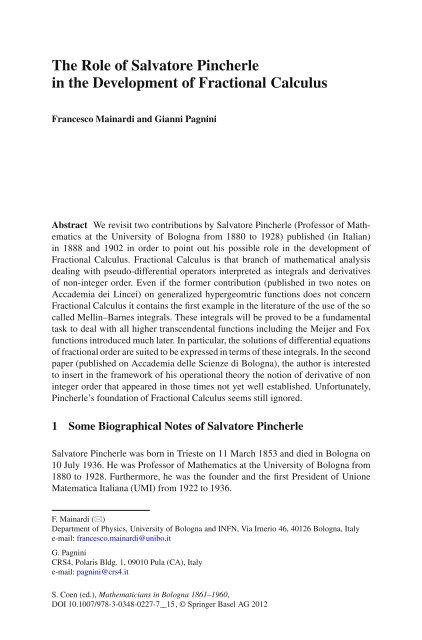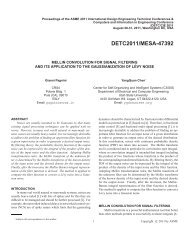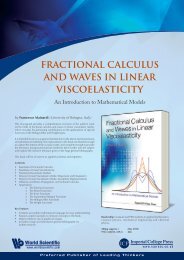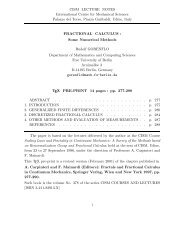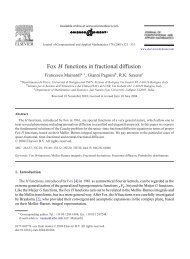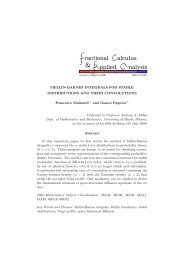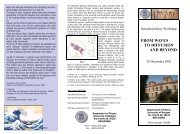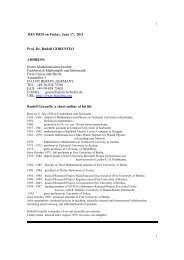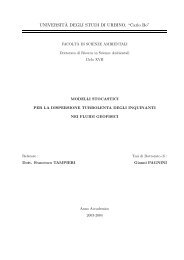The Role of Salvatore Pincherle in the Development of Fractional ...
The Role of Salvatore Pincherle in the Development of Fractional ...
The Role of Salvatore Pincherle in the Development of Fractional ...
Create successful ePaper yourself
Turn your PDF publications into a flip-book with our unique Google optimized e-Paper software.
<strong>The</strong> <strong>Role</strong> <strong>of</strong> <strong>Salvatore</strong> <strong>P<strong>in</strong>cherle</strong><br />
<strong>in</strong> <strong>the</strong> <strong>Development</strong> <strong>of</strong> <strong>Fractional</strong> Calculus<br />
Francesco Ma<strong>in</strong>ardi and Gianni Pagn<strong>in</strong>i<br />
Abstract We revisit two contributions by <strong>Salvatore</strong> <strong>P<strong>in</strong>cherle</strong> (Pr<strong>of</strong>essor <strong>of</strong> Ma<strong>the</strong>matics<br />
at <strong>the</strong> University <strong>of</strong> Bologna from 1880 to 1928) published (<strong>in</strong> Italian)<br />
<strong>in</strong> 1888 and 1902 <strong>in</strong> order to po<strong>in</strong>t out his possible role <strong>in</strong> <strong>the</strong> development <strong>of</strong><br />
<strong>Fractional</strong> Calculus. <strong>Fractional</strong> Calculus is that branch <strong>of</strong> ma<strong>the</strong>matical analysis<br />
deal<strong>in</strong>g with pseudo-differential operators <strong>in</strong>terpreted as <strong>in</strong>tegrals and derivatives<br />
<strong>of</strong> non-<strong>in</strong>teger order. Even if <strong>the</strong> former contribution (published <strong>in</strong> two notes on<br />
Accademia dei L<strong>in</strong>cei) on generalized hypergeomtric functions does not concern<br />
<strong>Fractional</strong> Calculus it conta<strong>in</strong>s <strong>the</strong> first example <strong>in</strong> <strong>the</strong> literature <strong>of</strong> <strong>the</strong> use <strong>of</strong> <strong>the</strong> so<br />
called Mell<strong>in</strong>–Barnes <strong>in</strong>tegrals. <strong>The</strong>se <strong>in</strong>tegrals will be proved to be a fundamental<br />
task to deal with all higher transcendental functions <strong>in</strong>clud<strong>in</strong>g <strong>the</strong> Meijer and Fox<br />
functions <strong>in</strong>troduced much later. In particular, <strong>the</strong> solutions <strong>of</strong> differential equations<br />
<strong>of</strong> fractional order are suited to be expressed <strong>in</strong> terms <strong>of</strong> <strong>the</strong>se <strong>in</strong>tegrals. In <strong>the</strong> second<br />
paper (published on Accademia delle Scienze di Bologna), <strong>the</strong> author is <strong>in</strong>terested<br />
to <strong>in</strong>sert <strong>in</strong> <strong>the</strong> framework <strong>of</strong> his operational <strong>the</strong>ory <strong>the</strong> notion <strong>of</strong> derivative <strong>of</strong> non<br />
<strong>in</strong>teger order that appeared <strong>in</strong> those times not yet well established. Unfortunately,<br />
<strong>P<strong>in</strong>cherle</strong>’s foundation <strong>of</strong> <strong>Fractional</strong> Calculus seems still ignored.<br />
1 Some Biographical Notes <strong>of</strong> <strong>Salvatore</strong> <strong>P<strong>in</strong>cherle</strong><br />
<strong>Salvatore</strong> <strong>P<strong>in</strong>cherle</strong> was born <strong>in</strong> Trieste on 11 March 1853 and died <strong>in</strong> Bologna on<br />
10 July 1936. He was Pr<strong>of</strong>essor <strong>of</strong> Ma<strong>the</strong>matics at <strong>the</strong> University <strong>of</strong> Bologna from<br />
1880 to 1928. Fur<strong>the</strong>rmore, he was <strong>the</strong> founder and <strong>the</strong> first President <strong>of</strong> Unione<br />
Matematica Italiana (UMI) from 1922 to 1936.<br />
F. Ma<strong>in</strong>ardi ()<br />
Department <strong>of</strong> Physics, University <strong>of</strong> Bologna and INFN, Via Irnerio 46, 40126 Bologna, Italy<br />
e-mail: francesco.ma<strong>in</strong>ardi@unibo.it<br />
G. Pagn<strong>in</strong>i<br />
CRS4, Polaris Bldg. 1, 09010 Pula (CA), Italy<br />
e-mail: pagn<strong>in</strong>i@crs4.it<br />
S. Coen (ed.), Ma<strong>the</strong>maticians <strong>in</strong> Bologna 1861–1960,<br />
DOI 10.1007/978-3-0348-0227-7__15, © Spr<strong>in</strong>ger Basel AG 2012
F. Ma<strong>in</strong>ardi and G. Pagn<strong>in</strong>i<br />
<strong>P<strong>in</strong>cherle</strong> retired from <strong>the</strong> University just after <strong>the</strong> International Congress <strong>of</strong><br />
Ma<strong>the</strong>maticians that he had organized <strong>in</strong> Bologna s<strong>in</strong>ce 3–10 September 1928,<br />
follow<strong>in</strong>g <strong>the</strong> <strong>in</strong>vitation received at <strong>the</strong> previous Congress held <strong>in</strong> Toronto <strong>in</strong> 1924. 1<br />
<strong>P<strong>in</strong>cherle</strong> wrote several treatises and lecture notes on Algebra, Geometry, Real<br />
and Complex Analysis. His ma<strong>in</strong> book related to his scientific activity is entitled “Le<br />
Operazioni Distributive e loro Applicazioni all’Analisi"; it was written <strong>in</strong> collaboration<br />
with his assistant, Dr. Ugo Amaldi, and was published <strong>in</strong> 1901 by Zanichelli,<br />
Bologna, see [20]. <strong>P<strong>in</strong>cherle</strong> can be considered one <strong>of</strong> <strong>the</strong> most prom<strong>in</strong>ent founders<br />
<strong>of</strong> <strong>the</strong> Functional Analysis, as po<strong>in</strong>ted out by J. Hadamard <strong>in</strong> his review lecture “Le<br />
développement et le rôle scientifique du Calcul fonctionnel", given at <strong>the</strong> Congress<br />
<strong>of</strong> Bologna (1928). A description <strong>of</strong> <strong>P<strong>in</strong>cherle</strong>’s scientific works requested from him<br />
by Mittag-Leffler, who was <strong>the</strong> Editor <strong>of</strong> Acta Ma<strong>the</strong>matica, appeared (<strong>in</strong> French)<br />
<strong>in</strong> 1925 on this prestigious journal [19]. A collection <strong>of</strong> selected papers (38 from<br />
247 notes plus 24 treatises) was edited by Unione Matematica Italiana (UMI) on <strong>the</strong><br />
occasion <strong>of</strong> <strong>the</strong> centenary <strong>of</strong> his birth, and published by Cremonese, Roma 1954.<br />
2 <strong>P<strong>in</strong>cherle</strong> and <strong>the</strong> Mell<strong>in</strong>-Barnes Integrals<br />
Here, we po<strong>in</strong>t out that <strong>the</strong> 1888 paper (<strong>in</strong> Italian) <strong>of</strong> S. <strong>P<strong>in</strong>cherle</strong> on <strong>the</strong> Generalized<br />
Hypergeometric Functions led him to <strong>in</strong>troduce <strong>the</strong> afterwards named Mell<strong>in</strong>-<br />
Barnes <strong>in</strong>tegral to represent <strong>the</strong> solution <strong>of</strong> a generalized hypergeometric differential<br />
equation <strong>in</strong>vestigated by Goursat <strong>in</strong> 1883. <strong>P<strong>in</strong>cherle</strong>’s priority was explicitly<br />
recognized by Mell<strong>in</strong> and Barnes <strong>the</strong>mselves, as reported below.<br />
In 1907 Barnes, see p. 63 <strong>in</strong> [1], wrote: “<strong>The</strong> idea <strong>of</strong> employ<strong>in</strong>g contour <strong>in</strong>tegrals<br />
<strong>in</strong>volv<strong>in</strong>g gamma functions <strong>of</strong> <strong>the</strong> variable <strong>in</strong> <strong>the</strong> subject <strong>of</strong> <strong>in</strong>tegration appears to be<br />
due to <strong>P<strong>in</strong>cherle</strong>, whose suggestive paper was <strong>the</strong> start<strong>in</strong>g po<strong>in</strong>t <strong>of</strong> <strong>the</strong> <strong>in</strong>vestigations<br />
<strong>of</strong> Mell<strong>in</strong> (1895) though <strong>the</strong> type <strong>of</strong> contour and its use can be traced back to<br />
Riemann." In 1910 Mell<strong>in</strong>, see p. 326ff <strong>in</strong> [15], devoted a section (Sect. 10: Pro<strong>of</strong><br />
<strong>of</strong> <strong>The</strong>orems <strong>of</strong> <strong>P<strong>in</strong>cherle</strong>) to revisit <strong>the</strong> orig<strong>in</strong>al work <strong>of</strong> <strong>P<strong>in</strong>cherle</strong>; <strong>in</strong> particular,<br />
he wrote “Before we are go<strong>in</strong>g to prove this <strong>the</strong>orem, which is a special case <strong>of</strong> a<br />
more general <strong>the</strong>orem <strong>of</strong> Mr. <strong>P<strong>in</strong>cherle</strong>, we want to describe more closely <strong>the</strong> l<strong>in</strong>es<br />
L over which <strong>the</strong> <strong>in</strong>tegration preferably is to be carried out" [free translation from<br />
German].<br />
1 More precisely, as we know from <strong>the</strong> recent biography <strong>of</strong> <strong>the</strong> Swedish ma<strong>the</strong>matician Mittag-<br />
Leffler by Arild Stubhaug [22]: <strong>The</strong> f<strong>in</strong>al decision was to be made as to where <strong>the</strong> next <strong>in</strong>ternational<br />
ma<strong>the</strong>matics congress (<strong>in</strong> 1928) would be held; <strong>the</strong> options were Bologna and Stockholm. One<br />
strike aga<strong>in</strong>st Stockholm was <strong>the</strong> strength <strong>of</strong> <strong>the</strong> Swedish currency; it was said that it would simply<br />
be too expensive <strong>in</strong> Stockholm. Mittag-Leffler was also <strong>in</strong> favor <strong>of</strong> Bologna, and <strong>in</strong> that context he<br />
had contacted both <strong>the</strong> Canadian J.C. Fields and <strong>the</strong> Italian <strong>Salvatore</strong> <strong>P<strong>in</strong>cherle</strong>. <strong>The</strong> latter even<br />
asked Mittag-Leffler whe<strong>the</strong>r he would preside at <strong>the</strong> open<strong>in</strong>g meet<strong>in</strong>g <strong>of</strong> what <strong>in</strong> reality would be<br />
<strong>the</strong> first <strong>in</strong>ternational congress for ma<strong>the</strong>maticians s<strong>in</strong>ce 1912. This was because ma<strong>the</strong>maticians<br />
from Germany and <strong>the</strong> o<strong>the</strong>r Central Powers would be <strong>in</strong>vited to Bologna.
<strong>The</strong> <strong>Role</strong> <strong>of</strong> <strong>Salvatore</strong> <strong>P<strong>in</strong>cherle</strong> <strong>in</strong> <strong>the</strong> <strong>Development</strong> <strong>of</strong> <strong>Fractional</strong> Calculus<br />
<strong>The</strong> purpose <strong>of</strong> this section is, follow<strong>in</strong>g our 2003 paper [8], to let know <strong>the</strong><br />
community <strong>of</strong> scientists <strong>in</strong>terested <strong>in</strong> special functions <strong>the</strong> pioneer<strong>in</strong>g 1888 work by<br />
<strong>P<strong>in</strong>cherle</strong> on Mell<strong>in</strong>–Barnes <strong>in</strong>tegrals, that, <strong>in</strong> <strong>the</strong> author’s <strong>in</strong>tention, was devoted to<br />
compare two different generalizations <strong>of</strong> <strong>the</strong> Gauss hypergeometric function due to<br />
Pochhammer and to Goursat. In fact, dropp<strong>in</strong>g <strong>the</strong> details on which <strong>the</strong> <strong>in</strong>terested<br />
reader can be <strong>in</strong>formed from our paper [8], <strong>P<strong>in</strong>cherle</strong> arrived at <strong>the</strong> follow<strong>in</strong>g<br />
expression <strong>of</strong> <strong>the</strong> Goursat hypergeometric function<br />
.t/ D 1<br />
2 i<br />
Z aCi1<br />
a i1<br />
.x 1/.x 2/:::.x m/<br />
.x 1/.x 2/:::.x m 1/ ext dx; (1)<br />
where a >
F. Ma<strong>in</strong>ardi and G. Pagn<strong>in</strong>i<br />
have <strong>in</strong>troduced <strong>the</strong> G functions much before Meijer if he had <strong>in</strong>tended to pursue<br />
his orig<strong>in</strong>al arguments <strong>in</strong> this direction.<br />
F<strong>in</strong>ally, we like to po<strong>in</strong>t out that <strong>the</strong> so-called Mell<strong>in</strong>–Barnes <strong>in</strong>tegrals are an<br />
efficient tool to deal with <strong>the</strong> higher transcendental functions. In fact, for a pure<br />
ma<strong>the</strong>matics view po<strong>in</strong>t <strong>the</strong>y facilitate <strong>the</strong> representation <strong>of</strong> <strong>the</strong>se functions (as<br />
formerly <strong>in</strong>dicated by <strong>P<strong>in</strong>cherle</strong>), and for an applied ma<strong>the</strong>matics view po<strong>in</strong>t <strong>the</strong>y<br />
can be successfully adopted to compute <strong>the</strong> same functions. In particular we like to<br />
refer to our papers [9, 10] where we have derived <strong>the</strong> solutions <strong>of</strong> diffusion-wave<br />
equations <strong>of</strong> fractional order and <strong>the</strong>ir subord<strong>in</strong>ation properties by us<strong>in</strong>g <strong>the</strong> Mell<strong>in</strong>-<br />
Barnes <strong>in</strong>tegrals.<br />
3 <strong>P<strong>in</strong>cherle</strong>’s Foundation <strong>of</strong> <strong>Fractional</strong> Derivatives<br />
<strong>The</strong> <strong>in</strong>terest <strong>of</strong> S. <strong>P<strong>in</strong>cherle</strong> about <strong>Fractional</strong> Calculus was ma<strong>in</strong>ly motivated by <strong>the</strong><br />
fact that literature def<strong>in</strong>itions <strong>of</strong> derivation <strong>of</strong> not <strong>in</strong>teger order, now called fractional<br />
derivation, were arbitrary <strong>in</strong>troduced as generalization <strong>of</strong> some aspects <strong>of</strong> <strong>the</strong><br />
ord<strong>in</strong>ary <strong>in</strong>teger order derivation. This lack <strong>of</strong> a rigorous foundation attracted him.<br />
Remember<strong>in</strong>g that one <strong>of</strong> <strong>the</strong> research field <strong>of</strong> S. <strong>P<strong>in</strong>cherle</strong> was <strong>the</strong> operational<br />
calculus, it seems straightforward to th<strong>in</strong>k that for him it was natural to apply his<br />
knowledge <strong>in</strong> this field to derive <strong>the</strong> most rigorous def<strong>in</strong>ition <strong>of</strong> derivation <strong>of</strong> not<br />
<strong>in</strong>teger order. In fact, <strong>in</strong> <strong>the</strong> book [20] entitled Le operazioni distributive published <strong>in</strong><br />
1901 <strong>in</strong> collaboration with U. Amaldi, S. <strong>P<strong>in</strong>cherle</strong> analyzed <strong>the</strong> general properties<br />
<strong>of</strong> operators, and <strong>in</strong> particular <strong>of</strong> differential operators. This background <strong>in</strong>ducted<br />
him to search for a rigorous foundation <strong>of</strong> <strong>Fractional</strong> Calculus, which overcomes<br />
<strong>the</strong> arbitrar<strong>in</strong>ess <strong>of</strong> literature def<strong>in</strong>itions, deriv<strong>in</strong>g a generalized derivative operator<br />
which meets all <strong>the</strong> properties <strong>of</strong> differential operators <strong>in</strong> <strong>the</strong> most general sense.<br />
This problem was addressed by S. <strong>P<strong>in</strong>cherle</strong> <strong>in</strong> <strong>the</strong> memoir Sulle derivate ad <strong>in</strong>dice<br />
qualunque [18].<br />
In 1902, <strong>Fractional</strong> Calculus had put its basis with <strong>the</strong> works by Liouville [7],<br />
Riemann [21] Tardy[23], Holmgrem [6]. S. <strong>P<strong>in</strong>cherle</strong> was acqua<strong>in</strong>ted about <strong>the</strong>se<br />
works that however he considered to have a paramount flaw because <strong>the</strong>se fractional<br />
derivation was arbitrary def<strong>in</strong>ed.<br />
In particular, with respect to Liouville def<strong>in</strong>ition <strong>of</strong> not <strong>in</strong>teger derivation <strong>of</strong><br />
order s<br />
D s e zx D z s e zx ; (2)<br />
he observed that, from this arbitrary def<strong>in</strong>ition as an <strong>in</strong>genuos extension for not<br />
<strong>in</strong>teger s <strong>of</strong> <strong>the</strong> derivation <strong>of</strong> <strong>the</strong> exponential function, serious objections arise<br />
about <strong>the</strong> application <strong>of</strong> <strong>the</strong> distributive property <strong>of</strong> D s for a sum <strong>of</strong> <strong>in</strong>f<strong>in</strong>ite terms.<br />
Arbitrar<strong>in</strong>ess has been highlighted also for Riemann def<strong>in</strong>ition <strong>of</strong> D s ,whichwas<br />
related to <strong>the</strong> coefficient <strong>of</strong> <strong>the</strong> term h s when a function f.xC h/ is developed by a<br />
power series <strong>of</strong> terms h Cn with n 2 N . F<strong>in</strong>ally, also Holmgrem arbitrary assumed<br />
<strong>the</strong> derivation <strong>of</strong> not <strong>in</strong>teger order s as <strong>the</strong> <strong>in</strong>tegral
<strong>The</strong> <strong>Role</strong> <strong>of</strong> <strong>Salvatore</strong> <strong>P<strong>in</strong>cherle</strong> <strong>in</strong> <strong>the</strong> <strong>Development</strong> <strong>of</strong> <strong>Fractional</strong> Calculus<br />
D s f.x/ D<br />
1<br />
.m s/ Dm<br />
Z x<br />
.x z/ m s 1 f.z/ dz; (3)<br />
which was presented by Riemann himself. <strong>The</strong> same <strong>in</strong>tegral was used by<br />
Hadamard [5] <strong>in</strong> his research on Taylor series.<br />
<strong>The</strong> general properties <strong>of</strong> ord<strong>in</strong>ary differential operator <strong>of</strong> <strong>in</strong>teger order are<br />
1. It is uniquely def<strong>in</strong>ed for any analytical fuction,<br />
2. It is distributive,<br />
3. It satisfies an <strong>in</strong>dex law,<br />
4. It meets a composition law for Dm . / by <strong>the</strong> application <strong>of</strong> Dn (with n m)<br />
to and , as for example Dm .x / D xDm C mDm 1 .<br />
<strong>The</strong>n, <strong>the</strong> generalization <strong>of</strong> <strong>the</strong> derivative operator for not <strong>in</strong>teger order s is<br />
obta<strong>in</strong>ed by <strong>the</strong> construction <strong>of</strong> an operator As with <strong>the</strong> same properties <strong>of</strong> derivation<br />
<strong>of</strong> <strong>in</strong>teger order. Hence, for <strong>the</strong> whole space <strong>of</strong> analytical functions or a part <strong>of</strong> it<br />
named Q, <strong>the</strong> derivation <strong>of</strong> not <strong>in</strong>teger order s meets <strong>the</strong> follow<strong>in</strong>g constra<strong>in</strong>ts:<br />
1. It is def<strong>in</strong>ed for any value <strong>of</strong> s, both real and complex, and for any function <strong>of</strong> Q<br />
generat<strong>in</strong>g at least one function belong<strong>in</strong>g to <strong>the</strong> same space Q,<br />
2. It is distributive<br />
As. C / D As. / C As. / ;<br />
3. It solves <strong>the</strong> equation<br />
4. It solves <strong>the</strong> equation<br />
DAs 1 D As ;<br />
As.x / D xAs. / C sAs 1. / ;<br />
5. It reduces for <strong>in</strong>teger value <strong>of</strong> s D m to <strong>the</strong> operator Dm .<br />
In this case, <strong>in</strong> <strong>the</strong> space Q it is def<strong>in</strong>ed <strong>the</strong> derivation <strong>of</strong> not <strong>in</strong>teger order s and<br />
<strong>the</strong>n As corresponds to Ds .<br />
S. <strong>P<strong>in</strong>cherle</strong> derives such generalized operator Ds which emerges to be<br />
x s D s D<br />
1X<br />
nD0<br />
!<br />
s x<br />
n<br />
n<br />
.1 s C n/ Dn<br />
; (4)<br />
where !<br />
s s.s 1/:::.s n C 1/ .1C s/<br />
D D<br />
; (5)<br />
n<br />
nŠ<br />
.1C n/.1 C s n/<br />
is <strong>the</strong> b<strong>in</strong>omial coefficient and .z/, with z 2 C , is <strong>the</strong> Euler gamma function that<br />
for <strong>in</strong>teger argoument is related to <strong>the</strong> factorial by .1 C n/ D nŠ. Fur<strong>the</strong>rmore,by<br />
adopt<strong>in</strong>g <strong>the</strong> Gamma function property .1 C z/ D z.z/ it results that
.1 s C n/ D .1 s/.1 s/:::.n s/<br />
D . 1/ n .1 s/.s 1/:::.s n/<br />
n .1 s/.1 C s/ .s n/<br />
D . 1/ ;<br />
.1C s n/ s<br />
F. Ma<strong>in</strong>ardi and G. Pagn<strong>in</strong>i<br />
and by <strong>the</strong> def<strong>in</strong>ition <strong>of</strong> b<strong>in</strong>omial coefficient (5)formula(4) can be rewritten as<br />
x s D s D<br />
s<br />
.1 s/<br />
1X<br />
nD0<br />
. x/ n<br />
.s n/nŠ Dn<br />
: (6)<br />
S. <strong>P<strong>in</strong>cherle</strong> recognized that formula (6) was orig<strong>in</strong>ally obta<strong>in</strong>ed by Bourlet [2].<br />
However, S. <strong>P<strong>in</strong>cherle</strong> highlighted also that Bourlet obta<strong>in</strong>ed (6) assum<strong>in</strong>g as<br />
def<strong>in</strong>ition <strong>of</strong> derivation <strong>of</strong> not <strong>in</strong>teger order <strong>the</strong> same one given by Riemann, while<br />
S. <strong>P<strong>in</strong>cherle</strong> derived (6) as <strong>the</strong> necessery consequence <strong>of</strong> those properties that an<br />
operator must satisfy to be <strong>in</strong>tended as derivation <strong>of</strong> not <strong>in</strong>teger order.<br />
Before conclud<strong>in</strong>g <strong>the</strong> memoir, S. <strong>P<strong>in</strong>cherle</strong> also shows that when s is a negative<br />
<strong>in</strong>teger, i.e. s D m,formula(4) becomes<br />
D m D xm<br />
.m/<br />
1X<br />
nD0<br />
. x/ n<br />
nŠ.m C n/ Dn<br />
; (7)<br />
which he recognized to be <strong>the</strong> generalized Bernoulli formula given <strong>in</strong> Le operazioni<br />
distributive [20].<br />
<strong>The</strong>n <strong>the</strong> fractional derivation <strong>in</strong> <strong>the</strong> <strong>P<strong>in</strong>cherle</strong> sense is def<strong>in</strong>ed by (4) andit<br />
is emerged to be a series <strong>of</strong> weighted <strong>in</strong>teger derivations up to <strong>the</strong> <strong>in</strong>f<strong>in</strong>ite order.<br />
This fractional derivation is not related to usual def<strong>in</strong>itions <strong>in</strong> literature. But we<br />
remark that, differently from generally accepted def<strong>in</strong>itions <strong>of</strong> fractional derivation,<br />
S. <strong>P<strong>in</strong>cherle</strong> derived an operator which meets all <strong>the</strong> general constra<strong>in</strong>ts that a<br />
derivation operator must satisfies. Unfortunately, <strong>in</strong> spite <strong>of</strong> <strong>the</strong> rigorous foundation,<br />
<strong>the</strong> fractional derivation <strong>in</strong> <strong>the</strong> <strong>P<strong>in</strong>cherle</strong> sense is not considered by <strong>the</strong> community<br />
<strong>of</strong> fractional analysts.<br />
Moreover, we would like conclude this section stress<strong>in</strong>g that, s<strong>in</strong>ce <strong>P<strong>in</strong>cherle</strong>’s<br />
fractional derivation has been obta<strong>in</strong>ed by strong analogy with ord<strong>in</strong>ary differentiation<br />
satisfy<strong>in</strong>g all differential operator constra<strong>in</strong>ts, it could have a straightforward<br />
physical and geometrical <strong>in</strong>terpretation, at variance with <strong>the</strong> actual literature <strong>of</strong><br />
<strong>Fractional</strong> Calculus. This topic would be <strong>the</strong> argument <strong>of</strong> future analysis.<br />
In fact, consider<strong>in</strong>g <strong>the</strong> <strong>in</strong>terpretation <strong>of</strong> <strong>P<strong>in</strong>cherle</strong> fractional derivative as a<br />
weighted sum <strong>of</strong> <strong>in</strong>f<strong>in</strong>ity <strong>in</strong>teger derivative <strong>of</strong> order n, n D 0;1;:::;1,<strong>the</strong>n<br />
D s D<br />
1X<br />
w.nI x;s/D n<br />
nD0<br />
; (8)
<strong>The</strong> <strong>Role</strong> <strong>of</strong> <strong>Salvatore</strong> <strong>P<strong>in</strong>cherle</strong> <strong>in</strong> <strong>the</strong> <strong>Development</strong> <strong>of</strong> <strong>Fractional</strong> Calculus<br />
where w.nI x;s/ is <strong>the</strong> weight <strong>of</strong> derivative <strong>of</strong> order n given <strong>the</strong> po<strong>in</strong>t x and <strong>the</strong><br />
fractional order s and from normalization<br />
From (4)and(6) it follows that<br />
w.nI x;s/ D<br />
and <strong>the</strong> series (9) becomes<br />
1X<br />
w.nI x;s/ D<br />
nD0<br />
D<br />
!<br />
s<br />
n<br />
1X<br />
w.nI x;s/ D 1: (9)<br />
nD0<br />
.1 C s/<br />
x s<br />
sx s<br />
.1 s/<br />
n s<br />
s<br />
x sx<br />
D<br />
.1 s C n/ .1 s/<br />
1X<br />
nD0<br />
1X<br />
nD0<br />
. x/ n<br />
; (10)<br />
.s n/nŠ<br />
x n<br />
.1 C n/.1 C s n/.1 s C n/<br />
. x/ n<br />
: (11)<br />
.s n/nŠ<br />
F<strong>in</strong>ally, computation <strong>of</strong> series (11) will give also a solution to <strong>the</strong> problem <strong>of</strong> <strong>the</strong><br />
<strong>in</strong>terpretation <strong>of</strong> fractional derivation.<br />
4 Conclusions<br />
We have revisited two contributions (<strong>in</strong> Italian) by <strong>P<strong>in</strong>cherle</strong> on generalized<br />
hypergeometric functions, dated 1888, and on derivatives <strong>of</strong> any order, dated 1902,<br />
<strong>in</strong> order to po<strong>in</strong>t out a possible role that he could have played <strong>in</strong> <strong>the</strong> development<br />
<strong>of</strong> <strong>the</strong> <strong>Fractional</strong> Calculus <strong>in</strong> Italy and abroad. As a matter <strong>of</strong> fact, unfortunately,<br />
<strong>the</strong>se contributions rema<strong>in</strong>ed practically unknown to <strong>the</strong> specialists <strong>of</strong> <strong>Fractional</strong><br />
Calculus. However, we have recognized, s<strong>in</strong>ce our 2003 paper [8], that <strong>the</strong> 1888<br />
contribution if suitably cont<strong>in</strong>ued could have led to <strong>the</strong> <strong>in</strong>troduction <strong>of</strong> G functions<br />
before Meijer and used to deal with differential equations <strong>of</strong> fractional order. Up to<br />
nowadays <strong>the</strong> 1902 contribution has been ignored but <strong>in</strong> our op<strong>in</strong>ion <strong>the</strong> approach<br />
by <strong>P<strong>in</strong>cherle</strong> is worth to be pursued <strong>in</strong> <strong>the</strong> framework <strong>of</strong> <strong>the</strong> modern <strong>the</strong>ory <strong>of</strong><br />
<strong>Fractional</strong> Calculus. It is <strong>in</strong>terest<strong>in</strong>g to note that even a former pupil <strong>of</strong> <strong>P<strong>in</strong>cherle</strong> at<br />
<strong>the</strong> University <strong>of</strong> Bologna, Antonio Mambriani, ignored <strong>the</strong> approach <strong>of</strong> his mentor<br />
<strong>in</strong> his papers on differential equations <strong>of</strong> fractional order, preferr<strong>in</strong>g <strong>the</strong> approach<br />
by Holmgren, see e.g. [11, 12].<br />
Acknowledgements Research performed under <strong>the</strong> auspices <strong>of</strong> <strong>the</strong> National Group <strong>of</strong> Ma<strong>the</strong>matical<br />
Physics (G.N.F.M. – I.N.D.A.M.) and partially supported by <strong>the</strong> Italian M<strong>in</strong>istry <strong>of</strong> University
F. Ma<strong>in</strong>ardi and G. Pagn<strong>in</strong>i<br />
(M.I.U.R) through <strong>the</strong> Research Commission <strong>of</strong> <strong>the</strong> University <strong>of</strong> Bologna. <strong>The</strong> authors are grateful<br />
to Pr<strong>of</strong>. S. Coen for <strong>the</strong> discussions and <strong>the</strong> helpful comments.<br />
References<br />
1. Barnes, E.W. 1907. <strong>The</strong> asymptotic expansion <strong>of</strong> <strong>in</strong>tegral functions def<strong>in</strong>ed by generalized<br />
hypergeometric series. Proceed<strong>in</strong>gs <strong>of</strong> <strong>the</strong> London Ma<strong>the</strong>matical Society (Ser. 2) 5: 59–116.<br />
2. Bourlet, C. 1897. Sur les opérations en général et les équations différentielles l<strong>in</strong>éaires d’ordre<br />
<strong>in</strong>f<strong>in</strong>i. Annales de l’Éc. Normale (Ser. III) 14: 133–190.<br />
3. Dixon, A.L., and W.L. Ferrar. 1936. A class <strong>of</strong> discont<strong>in</strong>uous <strong>in</strong>tegrals. <strong>The</strong> Quarterly Journal<br />
<strong>of</strong> Ma<strong>the</strong>matics (Oxford Series) 7: 81–96.<br />
4. Fox, C. 1961. <strong>The</strong> G and H functions as symmetrical Fourier kernels. Transactions <strong>of</strong> <strong>the</strong><br />
American Ma<strong>the</strong>matical Society 98: 395–429.<br />
5. Hadamard, J. 1892. Essai sur l’étude des fonctions données par leur développement de Taylor.<br />
Journal de Mathématiques Pures et Appliquées (Série IV) 8: 101–186.<br />
6. Holmgren, Hj. 1865. Om differentialikalkylen med <strong>in</strong>dices af havd natur som helst (Calcolo<br />
differenziale a <strong>in</strong>dici qualunque). Kongliga (Svenska) Vetenskaps-Akademiens Handligar 5, No<br />
11, 83, Stockholm, 7 Mars 1865.<br />
7. Liouville, J. 1832. Mémoire sur le calcul des différentielles à <strong>in</strong>dices quelconques. J. Ecole<br />
Polytech. 13 Cahier 21: 71–162.<br />
8. Ma<strong>in</strong>ardi, F., and G. Pagn<strong>in</strong>i. 2003. <strong>Salvatore</strong> <strong>P<strong>in</strong>cherle</strong>: <strong>the</strong> pioneer <strong>of</strong> <strong>the</strong> Mell<strong>in</strong>-<br />
Barnes <strong>in</strong>tegrals. Journal <strong>of</strong> Computational and Applied Ma<strong>the</strong>matics 153: 331–342;<br />
[E-pr<strong>in</strong>t:http://arxiv.org/abs/math/0702520].<br />
9. Ma<strong>in</strong>ardi, F., Luchko, Yu., and G. Pagn<strong>in</strong>i. 2001. <strong>The</strong> fundamental solution <strong>of</strong> <strong>the</strong> spacetime<br />
fractional diffusion equation. <strong>Fractional</strong> Calculus and Applied Analysis 4(2): 153–192;<br />
[E-Pr<strong>in</strong>t http://arxiv.org/abs/cond-mat/0702419].<br />
10. Ma<strong>in</strong>ardi, F., Pagn<strong>in</strong>i, G., and R. Gorenflo. 2003. Mell<strong>in</strong> transform and subord<strong>in</strong>ation laws<br />
<strong>in</strong> fractional diffusion processes. <strong>Fractional</strong> Calculus and Applied Analysis 6(4): 441–459;<br />
[E-pr<strong>in</strong>t:http://arxiv.org/abs/math/0702133].<br />
11. Mambriani, A. 1941. Derivazione d’ord<strong>in</strong>e qualunque e la rísoluzione dell’equazione ipergeometrica.<br />
Boll. Unione Mat. Ital. (Ser. 2) 3: 9–18.<br />
12. Mambriani, A. 1942. La derivazione parziale d’ord<strong>in</strong>e qualunque e la rísoluzione<br />
dell’equazione di Euler e Poisson. Annali R. Scuola Normale Superiore, Pisa, Scienze Fis.<br />
Mat. (Ser. 2) 11: 79–97.<br />
13. Meijer, G.S. 1946. On <strong>the</strong> G function, I–VIII, Nederl. Akad. Wettensch. Proc. 49: 227–<br />
237, 344–356, 457–469, 632–641, 765–772, 936–943, 1063–1072, 1165–1175; see also <strong>the</strong><br />
translation to English <strong>in</strong> Indagationes Math. 8: 124–134, 213–225, 312–324, 391–400, 468–<br />
475, 595–602, 661–670, 713–723.<br />
14. Mell<strong>in</strong>, H. 1891. Zur <strong>The</strong>orie der l<strong>in</strong>earen Differenzengleichungen erster Ordnung. Acta Math.<br />
15: 317–384.<br />
15. Mell<strong>in</strong>, H. 1910. Abriss e<strong>in</strong>er e<strong>in</strong>heitlichen <strong>The</strong>orie der Gamma und der Hypergeometrischen<br />
Funktionen. Ma<strong>the</strong>matische Annalen 68: 305–337.<br />
16. Paris, R.B., and D. Kam<strong>in</strong>ski. 2001. Asymptotic and Mell<strong>in</strong>-Barnes <strong>in</strong>tegrals. Cambridge:<br />
Cambridge University Press.<br />
17. <strong>P<strong>in</strong>cherle</strong>, S. 1888. Sulle funzioni ipergeometriche generalizzate. Atti R. Accademia L<strong>in</strong>cei,<br />
Rend. Cl. Sci. Fis. Mat. Nat. (Ser. 4) 4: 694–700, 792–799 [Repr<strong>in</strong>ted <strong>in</strong> <strong>Salvatore</strong> <strong>P<strong>in</strong>cherle</strong>:<br />
Opere Scelte, ed. UMI (Unione Matematica Italiana) 1, 223–230, 231–239. Roma: Cremonese,<br />
1954.<br />
18. <strong>P<strong>in</strong>cherle</strong>, S. 1902. Sulle derivate ad <strong>in</strong>dice qualunque. Rendiconti R. Accademia Scienze,<br />
Istitituto di Bologna (Ser. V) 9: 745–758.
<strong>The</strong> <strong>Role</strong> <strong>of</strong> <strong>Salvatore</strong> <strong>P<strong>in</strong>cherle</strong> <strong>in</strong> <strong>the</strong> <strong>Development</strong> <strong>of</strong> <strong>Fractional</strong> Calculus<br />
19. <strong>P<strong>in</strong>cherle</strong>, S. 1925. Notices sur les travaux. Acta Ma<strong>the</strong>matica 46: 341–362.<br />
20. <strong>P<strong>in</strong>cherle</strong>, S., and U. Amaldi. 1901. Le operazioni distributive. Bologna: Zanichelli.<br />
21. Riemann, B. 1892. Versuch e<strong>in</strong>er allgeme<strong>in</strong>en Auffassung der Integration und Differentiation,<br />
14 Janvier 1847. In Bernhard Riemann’s Gesammelte Ma<strong>the</strong>matische Werke, ed.He<strong>in</strong>rich<br />
Weber with <strong>the</strong> assistance <strong>of</strong> Richard Dedek<strong>in</strong>d, 353–362. Leipzig: Teubner Verlag [Repr<strong>in</strong>ted<br />
<strong>in</strong> <strong>The</strong> collected works <strong>of</strong> Bernhard Riemann. New York: Dover, 1953].<br />
22. Stubhaug, A. 2010. Gösta Mittag-Leffler, A man <strong>of</strong> conviction, 666. Berl<strong>in</strong>: Spr<strong>in</strong>ger.<br />
23. Tardy, P. 1868. Sui differenziali a <strong>in</strong>dice qualunque. Annali Mat. Pura Appl. 1: 135–148.


